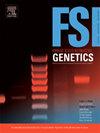X-chromosomal STRs: Metapopulations and mutation rates
IF 3.1
2区 医学
Q2 GENETICS & HEREDITY
引用次数: 0
Abstract
The analysis of STRs located on the X chromosome has been one of the strategies used to address complex kinship cases. Its usefulness is, however, limited by the low availability of population haplotype frequency data and lack of knowledge on the probability of mutations. Due to the large amount of data required to obtain reliable estimates, it is important to investigate the possibility of grouping data from populations with similar profiles when calculating these parameters. To better understand the partition of genetic diversity among human populations for the X-STRs most used in forensics, an analysis was carried out based on data available in the literature and new data (23,949 haplotypes in total; from these 10,445 new) obtained through collaborative exercises within the Spanish and Portuguese Working Group of the International Society for Forensic Genetics. Based on the available population data, a similarity in X-STR profiles was found in European populations, and in East Asian populations, except for some isolates. A greater complexity was found for African, South American, and South and Southeast Asian populations, preventing their grouping into large metapopulations. New segregation data on 2273 father/mother/daughter trios were also obtained, aiming for a more thorough analysis of X-STR mutation rates. After combining our data with published information on father/mother/daughter trios, no mutations were detected in 13 out of 37 loci analyzed. For the remaining loci, mutation rates varied between 2.68 × 10−4 (DXS7133) and 1.07x10−2 (DXS10135), being 5.2 times higher in the male (4.16 ×10−3) than in the female (8.01 ×10−4) germline.
x染色体STRs:元群体和突变率。
对位于X染色体上的STRs的分析一直是解决复杂亲属关系病例的策略之一。然而,它的有用性受到群体单倍型频率数据的低可用性和缺乏对突变概率的了解的限制。由于需要大量的数据来获得可靠的估计,因此在计算这些参数时,研究从具有相似概况的群体中分组数据的可能性是很重要的。为了更好地了解法医中最常用的x - str在人群中的遗传多样性划分,基于现有文献数据和新数据(共23,949个单倍型;通过国际法医遗传学学会西班牙和葡萄牙工作组的合作练习,从这10,445个新数据中获得。根据现有的种群数据,除个别分离株外,在欧洲种群和东亚种群中发现X-STR谱具有相似性。在非洲、南美、南亚和东南亚人群中发现了更大的复杂性,这阻止了他们分组成大的元种群。为了更全面地分析X-STR的突变率,我们还获得了2273个父亲/母亲/女儿三人组的新分离数据。在将我们的数据与已发表的父亲/母亲/女儿三胞胎的信息相结合后,在分析的37个位点中有13个未检测到突变。其余基因座的突变率在2.68 × 10-4 (DXS7133)和1.07 ×10- 2 (DXS10135)之间,雄性(4.16 ×10-3)是雌性(8.01 ×10-4)的5.2倍。
本文章由计算机程序翻译,如有差异,请以英文原文为准。
求助全文
约1分钟内获得全文
求助全文
来源期刊
CiteScore
7.50
自引率
32.30%
发文量
132
审稿时长
11.3 weeks
期刊介绍:
Forensic Science International: Genetics is the premier journal in the field of Forensic Genetics. This branch of Forensic Science can be defined as the application of genetics to human and non-human material (in the sense of a science with the purpose of studying inherited characteristics for the analysis of inter- and intra-specific variations in populations) for the resolution of legal conflicts.
The scope of the journal includes:
Forensic applications of human polymorphism.
Testing of paternity and other family relationships, immigration cases, typing of biological stains and tissues from criminal casework, identification of human remains by DNA testing methodologies.
Description of human polymorphisms of forensic interest, with special interest in DNA polymorphisms.
Autosomal DNA polymorphisms, mini- and microsatellites (or short tandem repeats, STRs), single nucleotide polymorphisms (SNPs), X and Y chromosome polymorphisms, mtDNA polymorphisms, and any other type of DNA variation with potential forensic applications.
Non-human DNA polymorphisms for crime scene investigation.
Population genetics of human polymorphisms of forensic interest.
Population data, especially from DNA polymorphisms of interest for the solution of forensic problems.
DNA typing methodologies and strategies.
Biostatistical methods in forensic genetics.
Evaluation of DNA evidence in forensic problems (such as paternity or immigration cases, criminal casework, identification), classical and new statistical approaches.
Standards in forensic genetics.
Recommendations of regulatory bodies concerning methods, markers, interpretation or strategies or proposals for procedural or technical standards.
Quality control.
Quality control and quality assurance strategies, proficiency testing for DNA typing methodologies.
Criminal DNA databases.
Technical, legal and statistical issues.
General ethical and legal issues related to forensic genetics.

 求助内容:
求助内容: 应助结果提醒方式:
应助结果提醒方式:


